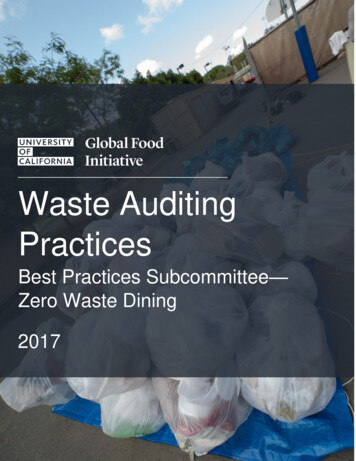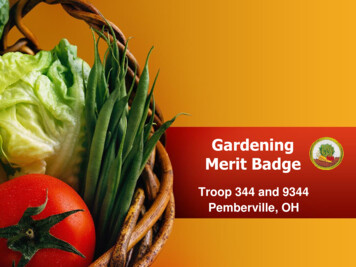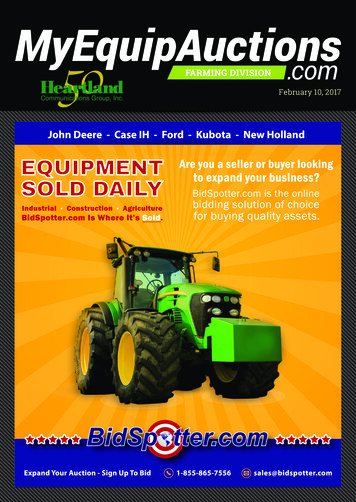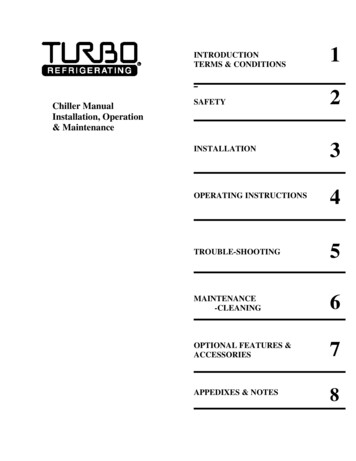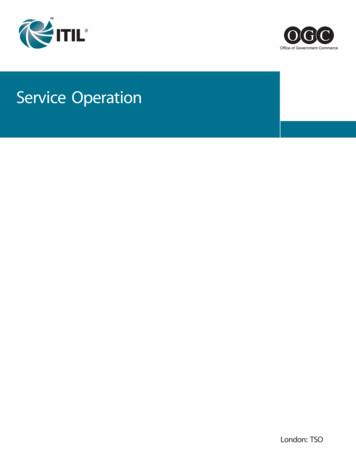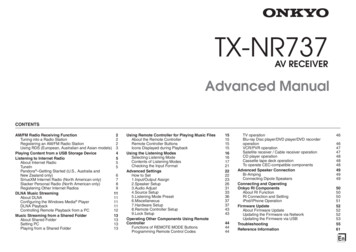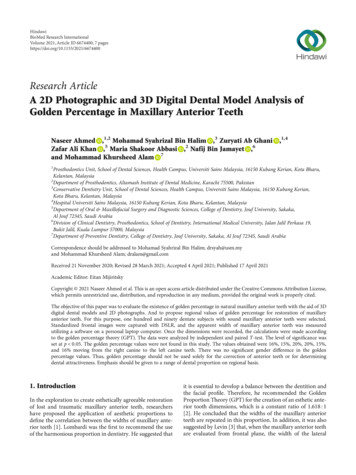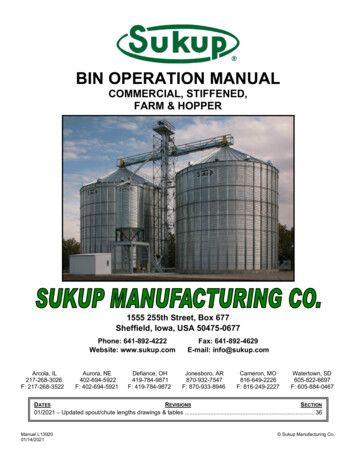
Transcription
BIN OPERATION MANUALCOMMERCIAL, STIFFENED,FARM & HOPPER1555 255th Street, Box 677Sheffield, Iowa, USA 50475-0677Phone: 641-892-4222Website: www.sukup.comArcola, IL217-268-3026F: 217-268-3522Aurora, NE402-694-5922F: 402-694-5921Defiance, OH419-784-9871F: 419-784-9872Fax: 641-892-4629E-mail: info@sukup.comJonesboro, AR870-932-7547F: 870-933-8946Cameron, MO816-649-2226F: 816-249-2227Watertown, SD605-822-6697F: 605-884-0467DATESREVISIONSSECTION01/2021 – Updated spout/chute lengths drawings & tables . 36Manual L1392001/14/2021 Sukup Manufacturing Co.
Thank you for purchasing Sukup equipment.At Sukup Manufacturing Co., we strive to provide ourcustomers with the best products available. It’simportant to us that you get the best value for yourmoney. That means producing top-quality products thatwill provide you with many years of satisfied ownership.We back our products with experienced staff and thebest customer service in the industry. Our dedicatedemployees have done their best to ensure that yourSukup equipment will meet your needs. With properinstallation and use, it will serve you for many years.If for some reason you experience difficulties with yourSukup equipment, your authorized Sukup dealer canprovide you with the help you need. If you needassistance beyond what your dealer can provide, you canalways contact your regional Sukup Distribution Centeror our headquarters in Sheffield, Iowa, USA.Thank you again for your purchase. We wish you manyyears of profitable, safe use of your Sukup equipment.Steve, Emily, Matt,Andy, Charles andThe Entire Sukup FamilySukup Manufacturing Co.Sheffield, Iowa, USA2
Table of ContentsWarrantyLimited WarrantyInitial Guidelines56SafetyRecognizing Safety Decal InformationGeneral Operational Safety ProceduresDangers of Entering a Grain Bin; Flowing & Crusted GrainBridged & Caked GrainMoving PartsLockout/Tagout; Ventilation; Sharp Edges & ObstaclesFalls & Obstructions; Ladder SafetyFall Restraints & Arrest SystemsKnot-Passing Pulley & Restraint AnchorTop Causes of Bin FailureConstruction Safety7891011121314151617Planning PreparationsSite SelectionElectrical Wire ClearanceComponent LocationSelecting Builders & Contractors; FoundationAnchor Bolt Guidelines1819202122-26Bin Operation & ManagementBin DescriptionBin UsageInitial FillLoadingUnloadingSweeping BinMaterial StoredSpout/Chute LengthsVentilationTemperature Cables; Additional LoadsStiffener LoadsSidedrawHopper Bottom Bins27282930313233-353637-38394041-4243Managing Stored GrainBasic PrinciplesGrain StorageAerationGrain DryingDrying Guidelines to Prevent Spoilage along Bin WallDrying nanceTroubleshootingMaintenanceReplacement Parts5859-61613
4
GRAIN BIN LIMITED WARRANTYSUKUP MANUFACTURING CO. (Sukup) warrants, to original retail purchaser within 5 years from date of purchase, that grainbin shall be free from defects in material and workmanship. A part will not be considered defective if it substantially fulfillsperformance specifications, such as cosmetic (appearance) issues that will not affect life of the structure. Should any part provedefective within warranty period, part will be replaced without charge F.O.B. Sukup Manufacturing Co., Sheffield, Iowa USA orDistribution Centers - Arcola, Illinois; Aurora, Nebraska; Defiance, Ohio; Jonesboro, Arkansas; Cameron, Missouri;Watertown, South Dakota. To obtain warranty, a copy of original invoice is required.WARRANTY CERTIFICATION - Warranty registration card should be mailed within two weeks of product delivery to certifywarranty coverage.THE FOREGOING LIMITED WARRANTY IS EXCLUSIVE AND IN LIEU OF ALL OTHER WARRANTIES OFMERCHANTABILITY, FITNESS FOR PARTICULAR PURPOSE AND OF ANY OTHER TYPE, WHETHER EXPRESS ORIMPLIED. Sukup neither assumes nor authorizes anyone to assume for it any other obligation or liability in connection with saidpart, and will not be liable for incidental or consequential damages. REMEDIES STATED HEREIN SHALL BE THE EXCLUSIVEREMEDIES AVAILABLE UNDER THIS LIMITED WARRANTY.Sukup reserves the right to change specifications, add improvements or discontinue manufacture of any of its equipment withoutnotice or obligation to purchasers of its equipment. This warranty gives you specific legal rights. You may also have other rightswhich vary according to state or province.WARRANTY EXCLUSIONS - Labor, transportation, or any cost related to a service call is not provided by Sukup. This LimitedWarranty does not apply to damage resulting from misuse, neglect, normal wear, accident or improper installation ormaintenance. ITEMS NOT MANUFACTURED BY SUKUP ARE COVERED UNDER WARRANTIES OF THEIR RESPECTIVEMANUFACTURERS AND ARE EXCLUDED FROM COVERAGE UNDER THE SUKUP WARRANTY.SUKUPMANUFACTURING CO. MAKES NO WARRANTY, EXPRESS OR IMPLIED, OF MERCHANTABILITY OR FITNESS FOR APARTICULAR PURPOSE.Foundation recommendations are suggestions only and will vary according to local soil conditions. Soil bearing tests must beperformed by a competent, independent engineering firm. Sukup will not assume responsibility for adverse result arising fromtheir use. Sukup will not warrant damage or loss caused, in whole or in part, by inadequate or improper site selection, sitepreparation, foundation, or any other failure to provide a suitable erection or installation environment for Sukup grain bin or ofany product, component, equipment, accessories, parts used in conjunction with Sukup grain bin. Sukup will not warrantdamage or loss caused, in whole or in part, by use of bin in a manner other than for which it was designed, or by unauthorizedattachments, modifications, alterations, improper or inadequate maintenance, misuse or abuse of the bin.Sukup is not liable for direct, indirect, incidental or consequential damages, including, without limitation, loss of anticipatedprofits or benefits. Not responsible for field modifications or erection defects which create structural or storage quality problems.WARRANTY IS VOID - If not purchased from or constructed by an authorized dealer or a representative of SukupManufacturing Co.; If used for substances other than grains and/or free flowing materials.Prior to installation, purchaser has responsibility to properly store steel bin components. Bin should be stored in dry,temperature and humidity controlled areas to eliminate condensation and other moisture that causes white rust and corrosion.Warranty does not extend to defects, damages or cosmetic (appearance) issues caused by improper storage or handling.Sukup does not warrant any roof damage caused by excessive vacuum or internal pressure from fans or other air movingsystems. Adequate ventilation and/or “make-up air” devices should be provided for all powered air handling systems. Warrantyis void if grain is above eave and against roof, as this will block roof vents and cause unwanted loads on roof sheets. Areaabove surface of grain must allow free movement of air to vents. Sukup does not recommend use of downward flow systems(suction). Severe structural roof damage may occur if fans or other air moving devices are operated during certain highhumidity/cold weather conditions. Roof ventilators may frost over and plug or restrict air flow causing excessive vacuum orinternal pressures. Roof damage may occur due to improperly installed grain temperature detection cable systems.Sukup does not warrant failures due to filling bin off-center; unloading from door or off-center floor sump; or radial cracks infoundation. If bin has a perforated floor on columns and columns fail, bin can shift sideways causing both sidewall and roofdamage.UNAPPROVED PARTS OR MODIFICATION - All obligations of Sukup under this warranty are terminated if unapproved partsare used, equipment is modified or altered in any way not approved by Sukup in writing, or is not erected or operated accordingto Sukup installation or operating manuals.2/21/185
Initial GuidelinesSukup grain bins are designed and manufactured to withstand the constant forces applied when filled withgrain. When properly installed and operated, these structures will provide many years of service.Contractors and Owners who plan to construct the bin themselves must follow guidelines listed below.Doing so will ensure the owner has a properly installed and operating grain bin.-Erection manuals and assembly drawings must be thoroughly studied prior to construction. Properknowledge of the individual assembly procedures will aid in safety and speed of construction. Be certainall holes are filled with correct sized bolts as stated in construction manual.-NOTE: Procedures and guidelines listed in this manual are recommended as part of the specificmeasures and actions established per job. Due to the numerous situations at each site, SukupManufacturing Co. is unable to provide a specific procedure checklist for each individual location.Owners/Operators are responsible for developing specific procedures and guidelines based onequipment, conditions and situations at their individual locations.-Contractor and owner must followmanuals and assembly drawings suppliedwith products. IMPORTANT: Keepgalvanized sheets dry before erecting!See guidelines at right. SukupManufacturing Co. will not honor claimsfor damage resulting from exposure ofthese materials to moisture.-If any questions arise about instructionsand/or assembly drawings, before orduring construction, contact Sukup’scustomer service. They will refer you tosomeone who can clarify any questionsabout instructions and/or drawings andresolve any problem(s) you may haveduring assembly.-Failing to follow any installation,operation or maintenance instructionsestablished by Sukup ManufacturingCo. or failure of product resulting fromexposure to corrosive materials,misuse, accident, normal wear andtear, unauthorized e procedures prior to erection,or improper storage of grain will voidthe manufacturer’s warranty and mayresult in death, serious injury orstructural damage.Please read entire Bin Operation Manual and Construction Manual, paying close attention to safetysections. Failure to read these manuals is a misuse of the product and could result in death or personalinjury or property damage. All personnel associated with the bin must read these manuals thoroughly aswell.Although every effort is made to ensure assembly drawings and instructions are written without errors, theymay happen. Therefore, if any concerns arise regarding any instructions or assembly drawings, pleasecontact Sukup Manufacturing Co. customer service immediately for clarification prior to proceeding withconstruction.6
Recognizing Safety Decal InformationRead manual before installing or using product. Failure to follow instructions and safety precautions inmanual can result in death or serious injury. Keep manual in a safe location for future reference.On safety decals, this symbol and the signal words Danger, Warning, Caution and Notice draw yourattention to important instructions regarding safety. They indicate potential hazards and levels ofintensity.RED - DANGER indicates an imminently hazardous situation which, if not avoided, willresult in death or serious injury.ORANGE - WARNING indicates a potentially hazardous situation which, if notavoided, could result in death or serious injury.YELLOW - CAUTION indicates a potentially hazardous situation which, if not avoided,may result in minor or moderate injury.BLUE - NOTICE alerts you to practices unrelated to personal injury, such as messagesrelated to property damage.IMPORTANT: To prevent serious injury or death to you or your family, be certain that all decals are in placeaccording to illustration below and are legible. If a suggested location is not clearly visible, place decal in amore suitable area. Additional safety decals are available at no charge for Sukup equipment. Please specifydecal number when ordering. See contact information on cover of manual.7
General Operational Safety ProceduresWARNING: Make hazards known to all personnel working in area so they can takeappropriate safety precautions. Failure to follow precautions listed below maycause death or serious injury. Hands, feet and clothing must be kept away from moving parts. Loose clothing can becomeentangled in moving parts and cause serious injury. Be aware of danger that is present when loading and unloading bin. Flowing and crusted graincan trap and suffocate. Do not enter bin without having an observer outside who is in constant contact with you. Decals with specific messages are attached to equipment at various locations. Pay attention tomessages and always be alert to the possibility of personal injury or death. Keep all guards and shields in place and secure while machines are in operation. Ladders and working surfaces should have safety cages and handrails for safe use. Use alifeline and harness when danger of falling exists. Keep bystanders and children away from grain bins and grain handling equipment. Bin sitesare not playgrounds! Bins must be labeled to warn of entrapment and flowing grain hazards. Proper operational procedures must be followed to ensure safety and well-being of all personsworking near or on grain bins when inspecting grain, performing maintenance or sprayinginsecticides. Hazards associated with grain bins include engulfment in grain, falls from heights, dust andmold inhalation, pesticide exposure, electrocution, and injuries from augers. Take precautionarysteps to avoid these hazards. Learn how to use controls and operate equipment correctly. Do not let anyone operate unit(especially youth) without thorough training of basic operating and safety procedures. Periodically check all mechanical and electrical components to keep them in good workingcondition. Make no unauthorized modifications to equipment. Doing so may endanger functionand safety of unit. Be aware of weather-related safety hazards. Icicles and snow falling from bin eave aredangerous and can cause serious injury or death. Ice or moisture on ladders can cause slipperyconditions that may result in a life-threatening fall. For added security and safety, attach a padlock to sidewall door latch. If you must enter bin, shut off equipment and lock out all power sources before entering; keepclear of all moving parts; use a safety harness and safety line, station another person outside ofbin; avoid center of bin; wear proper breathing equipment or respirator; follow applicable safetyregulations; ensure quick access to an ABC dry chemical fire extinguisher.8
Dangers of Entering a Grain BinNo one should enter a grain bin while it is being loaded or unloaded due to risk of being injured by movingparts such as augers or being crushed and/or suffocated by grain. Entering a bin that has bridged or crustedgrain is very dangerous. Working in a grain bin without following proper safety procedures increases anindividual’s chance of being suffocated. If grain is peaked close to roof, do not enter bin. Crawling betweenroof and peak could cave grain and block exit.Owners/operators are responsible for developing site-specific confined space entry procedures. OSHA’sconfined space entry procedures (29CFR 1910.146) can be found at www.osha.gov.Flowing & Crusted GrainPeople can become caught or trapped by grain in several ways: entrapment by flowing grain, collapse ofbridged grain, and collapse of a vertical wall of grain. To better understand why grain flow is so dangerous,you must understand how grain flows when it is unloaded. Grain bins are first emptied through the centersump (bins erected with a sidedraw are only exception). When center sump is opened and auger is started,grain flows from top surface down a center core to center sump. This is called funnel flow and is illustrated infigures below.Based on 8” unload auger2 secondsFrom time auger starts, youhave 2 seconds to react.4 secondsIn 4 secondsyou are trapped8 secondsAfter 8 seconds, you arecompletely covered.Grain across bottom and around sides of bin does not move. The speed at which grain is removed makesthe funnel flow very dangerous. A person in a bin would be carried to center, quickly drawn under, andsuffocated. An 8” auger can transfer 3,000 cubic feet of grain per hour (52 cubic feet per minute). A personabout 6’ tall displaces about 7-1/2 cubic feet, assuming an average body diameter of 15 inches. This meansthe entire body could be submerged in a funnel in about 8 seconds. Even more importantly, you could be upto your knees and totally helpless to free yourself in less than 4 seconds.Grain surface may appear solid but not be. A small opening in unload gate gives entire surface the quality ofquicksand. When a single kernel is removed from bottom of bin, kernels directly above it rush to fill the void.Flowing grain is fluid. Objects on surface sink and heavy objects sink faster than small ones.Flowing grain is like water in that it will exert pressure over entire area of any object that is submerged in it.However, the amount of force required to pull someone up through grain is much greater than in waterbecause grain exerts no buoyant force and has much greater internal friction.9
Even if grain has stopped flowing, submerged objects or people are difficult to extract. Even victims withtremendous upper-body strength cannot pull themselves out if they are buried to the chest. The forcerequired to remove someone buried below the surface of grain can easily exceed 2,000 pounds, which isabout the same as needed to lift a small car.If you become trapped in a bin of flowing grain with nothing to hold onto but you are still able to walk, staynear outside wall. Keep walking until bin is empty or grain flow stops. If you become covered in flowinggrain, cup your hands over your mouth and take short breaths. This may keep you alive until help arrives.Additional personnel should call for an emergency rescue team or fire department immediately. Ventilate binwith an aeration system but DO NOT activate heat source. Wait for emergency crews to arrive beforeattempting rescue. Offer assistance to rescuers and follow directions given by incident commander.Bridged & Caked GrainSpoiled grain tends to clump together and grain that is stored in cold temperatures can appear to have asolid surface while, in reality, it may collapse if walked upon. Be aware of a potential engulfment hazardwhen walking on surface crust. Never enter a bin unless you know the nature of previous grain removal,especially if any crusting is evident. Proper safety precautions must be taken. After grain has beenremoved, look for a funnel shape at surface of grain mass. If grain appears to be undisturbed, then ithas bridged and created a cavity.Bridged grain may create air spaces in a partially unloaded bin (see above). As grain is removed from bin, acavity develops under crusted surface. This situation presents several dangers. First, the person may breakthrough the surface and be trapped instantly in flowing grain. Another danger is that a large void may becreated under the bridge by previous unloading so that a person who breaks through crust may be buriedunder grain and suffocate, even without auger running. The third hazard is that if grain is wet enough tomold and bridge across bin, there may be little oxygen present in cavity due to microbial gases. A personfalling into a cavity will be forced to breathe toxic gases, even though his head is above surrounding grain.From outside of bin, use a pole or other object to break bridge, causing it to collapse.Grain can also cake in a large mass against wall when it has been stored improperly or in poor condition.Mass of grain can cause engulfment or crushing hazards to workers who attempt to break grain loose withshovels or other objects.This risk increases as capacity of bin increases. A person lying prone and covered by 1 foot of grain will besubjected to a force of over 300 lbs. Be alert while working with grain that has gone out of condition.Entering a bin when there may be molds, blocked flow, cavities, crusting, and possible cave-ins can costyou your life. When you are breaking up large masses of vertically crusted grain, do so with a long woodenpole from manhole above grain.10
Moving PartsWhen bin is nearly empty, sweep (floor) auger travels at a faster speed around bin. If caught in rotatingauger, a body part can be pulled along with grain, cutting and tearing flesh. Also, an exposed auger in asump can cause serious injury if sump is stepped into or fallen into. All shields should be in place to preventbody parts from getting caught.To help prevent tragedy, SAFETY SHOULD BE THE TOP PRIORITY. Preparation is the first and mostimportant step. Failure to follow precautions listed below may cause death or serious injury. Keep hands, feet and clothing away from moving parts. Loose clothing can become entangled inrotating parts and cause serious injury or death. Guards and shields are provided for your protection. Make sure all are secure and in place whilemachine is in operation. Replace safety shields that have been damaged or were removed for servicing equipment. Fastenshields securely. Be sure to wear tight-fitting clothing when working near a grain auger. Loose, floppy clothing, longshoestrings and drawstrings on hooded jackets can easily become entangled in rotating parts.Entangled clothing will pull the body into moving machinery and severe injury will result. Limit number of people around augers when in use. Only those who are essential to job should bethere. Watch children closely. Never leave them unattended. Keep them away from vehicles, flowing grainand moving parts. Small hands and feet can penetrate even properly shielded augers, belts andPTOs. Teach children which areas are safe and which are not. Be certain all machinery is in good working condition.11
Lockout/TagoutLockout/Tagout refers to specific practices and procedures to safeguard against unexpected energization orstartup of machinery and equipment or release of hazardous energy during service or maintenanceactivities. This requires, in part, that an authorized individual isolate machinery or equipment from its energysource(s) before performing service or maintenance. It also requires authorized individual(s) to either lock ortag energy-isolating device(s) to prevent release of hazardous energy, and take steps to verify energy hasbeen isolated effectively.Grain storage structures and handling equipment may create hazardous work areas. Individuals shouldmake sure they take proper steps to prevent injuries, illness or death. Be certain proper lockout/tagoutprocedures are followed before performing any service on equipment or entering bin.Lockout refers to a device that uses a lock -- either key or combination type -- to hold an energy-isolatingdevice in a safe position and prevent energizing of a machine or equipment. This device ensures thatequipment being controlled cannot be operated until lockout device is removed. Tags must be used with alllocking devices. Tags should be affixed in a manner that clearly identifies the individual servicing theequipmentTagout refers to placement of a tag on a device that is not capable of being locked out, to indicateequipment may not be operated until tag device is removed. These tags are singularly identified with theindividual applying the device and servicing the equipment. These tags do not provide physical restraint onthose devices that require a restraint.Owners/Operators are responsible for developing site-specific Lockout/Tagout procedures based onequipment, conditions and situations at their individual locations. OSHA’s Lockout/Tagout procedures(29CFR 1910.147) can be obtained at www.osha.gov.VentilationWhen entering an inadequately ventilated area, individuals may be at risk of being overcomeby respiratory hazards (gases, fumes and dust) that can cause permanent lung damage oreven death. Working in grain bins without proper respiratory protection increases a person’schance of developing a respiratory disease.Owners/Operators are responsible for developing site-specific personal protectiveequipment standards. OSHA’s personal protective equipment standards (29CFR 1910.134)can be obtained at www.osha.gov.Sharp Edges & ObstaclesWhen working in, on or near a bin, remember that metal edges are sharp. Toavoid injuries, wear protective clothing and handle equipment and parts withcare. An excellent safety practice is to keep bin site clear of scrap iron andother foreign materials that may get covered up by snow or tall grass. Items ordebris left near bin site may interfere with safe, unobstructed movement aroundbin.Be aware of trucks, tractors, wagons, augers, hoppers and pits, etc. Neverallow anyone to ride on trucks equipped with grain beds or gravity dumpwagons. Keep children off grain vehicles and out of bins while loading andunloading. Always know where all family members are (especially children) atall times when grain is being loaded, unloaded, moved or otherwise handled.12
Falls & ObstructionsFalls from grain bins at any height can cause injury. Ladders on bins can become very slippery or icy ininclement weather. Maintain a secure handhold and foothold when climbing on bin. Metal is slippery whenwet. Never carry items while climbing on bins. Also, be certain no obstacles are in front of ladder.Slippery metal, broken or loose ladder rungs and loose handholds can be very dangerous. Repair looseladder rungs and handholds as soon as they are discovered. Follow maintenance guidelines listed at backof operation manual to prevent serious injury.Make sure there are no obstructions nearladder rungs. Be certain wind rings (usuallyon taller commercial bins) are installedaccording to illustration at right so adequateclearances for hands and feet are provided.Wind rings must be a minimum of 1-1/2”below and 4-1/2” above any ladder rung. Awind ring assembled within 4-1/2” above aladder rung can interfere with foothold andcause you to fall. Center of outside laddermust be at least 7” from E: Failure to install ladder and safetycages correctly and to use fall restraint orarrest systems correctly may cause deathor serious injury. Contact your dealer ifproper ladder and accessories are notinstalled.LADDER RUNGLADDER1-1/2” MINIMUMBELOW LADDERRUNG11”7” MINIMUMFROM BINSIDEWALL TOCENTER OFLADDERRUNG4-1/2” MINIMUMABOVE LADDERRUNGLadder Safety Working load of ladder is 300 pounds. Do not overload.Inspect ladder carefully before use. Never climb deteriorated, damaged or improperly assembledladder components.Never use ladder if you are physically impaired.Never carry items while climbing.Always have another person present while climbing.Use safety harness and safety line as required.Metal is slippery when wet. Always maintain a firm grip and wear slip-resistant shoes when climbing.Always face ladder when using it.Never apply external load. Never push or pull anything while on ladder.WARNING: Failure to follow precautions above may result in death or serious injury.13
Fall Restraints & Arrest SystemsWhen working at a height where fall hazards exist, always use a fall restraint or fall arrest system. Inspectcomponents before each use for wear, damage and other deterioration. Remove defective components fromservice according to manufacturer’s instructions. Failure to heed this warning may cause death or seriousinjury.A fall restraint system consists of a body belt or harness, lanyard and anchor. The system is arranged sothe individual is prevented from falling. Fall restraint systems should be used in accordance withmanufacturer’s recommendations and instructions.A fall arrest system consists of a harness, lanyard and anchor. The system stops a fall within specifiedparameters. Fall arrest systems should be used in accordance with manufacturer’s recommendations andinstructions.Lifelines and safety harnesses are used with both systems. A lifeline is acomponent consisting of a flexible line (rope or cable) for connection to ananchorage at one end to hang vertically (vertical lifeline), or for connection toanchorages at both ends to stretch horizontally (horizontal lifeline). Lifelines alsoserve as a means for connecting other components of a fall protection system. Asafety harness has straps that wrap around an individual in a manner that willdistribute the fall arrest forces over thighs, pelvis, waist, chest, and shoulders witha means of attaching it to other components of a fall protection system. Followmanufacturer’s instructions when using a lifeline and safety harness.Individuals who enter a grain storage structure from a level at or above stored grain should be equipped witha lifeline and harness. When entering any bin or storage unit, have multiple people outside and one inside. Asingle person cannot go for help and give first aid simultaneously.Connections outside bin on roof should be made to peak ring. Lifelines should not let individual extend pasteave of roof. If work needs to be done on portions of sidewall, proper equipment such as lifts or cranesshould be used. When working inside bin, appropriate connections should be made to rafters, peak ring orsidewall.NOTE: Fall-protection equipment used with bin ladder will depend on height of ladder and whether federalOccupational Safety and Health Administration rules apply to bin site. If ladder is 24’ tall or taller and bin ison an OSHA-defined commercial site (11 or more full-time employees), fall-arrest cable system must beused. On sites where OSHA rules do not apply, safety cages can be used instead. See Ladders, SafetyCages & Platforms section in bin erection manual.DISCLAIMER: It shall be the sole responsibility of the customer to determine applicability of OSHA fallprotection rules at bin site. S
Managing Stored Grain Basic Principles 44-45 Grain Storage 45-48 Aeration 49 Grain Drying 50-54 Drying Guidelines to Prevent Spoilage along Bin Wall 55 Drying Precautions 56 Refer
